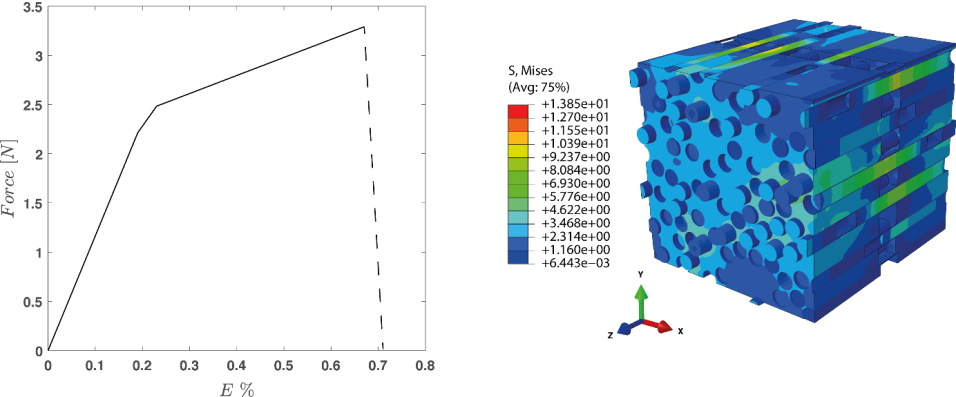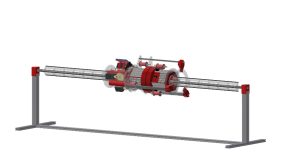Extended projects 2017 cohort
- Increasing the damage tolerance of carbon fibre reinforced thermoset composites: a use for multifunctional nonwoven interleaves
- Mechanical performance, microstructural analysis and residual stress of multiple oxide ceramic matrix composite systems
- Micro-scale Analysis of Progressive Damage in Ceramic Matrix Composites
- A one-dimensional snap-through model of the aeroelastic tymbal sound production in Yponomeutidae moths
- Continuous Extrusion of Ultra-Efficient Truss Structures
- Understanding of Leading-Edge Protection Performance Using Nano-Silicates for Modification
- Reducing the melting point and enhancing the stability of MOFs through the generation of novel functional MOF/polymer nanocomposites
- Adaptive Mesh Segmentation for Modelling Dynamic Delamination Initiation and Propagation in Thick Composite Laminates
- Surface modification of UHMWPE fibres with Ar-O2 plasma treatment
- Development of Novel Transportation Shells for use in High Volume Composite Preform Processes
Increasing the damage tolerance of carbon fibre reinforced thermoset composites: a use for multifunctional nonwoven interleaves
 Student: Eileen Atieno
Student: Eileen Atieno
Supervisors: Ian Hamerton and Thomas Pozegic
Increase in demand for high performance materials has led to a higher use of carbon fibre reinforced polymer (CFRP) composites in the Aerospace industry. The main obstacle that limits widespread use of CFRPs is their low interlaminar fracture toughness (IFT) making them highly susceptibility to interlaminar separation or delamination as a result of crack propagation when subjected to mode I and mode II load cases as well as out-of-plane, low velocity impacts; leading to formation of local stress concentrations and reduction in residual compressive strength and stiffness.
This project aims to fabricate interleaved CFRP composite laminates using nonwoven electrospun PA-6,6 (nylon) veils with two different morphologies. The first one included a neat nonwoven veil made from PA-6,6 fibres, used as a control, the second had different graphene wt.% loadings used to reinforce veil fibres and the final one involved spray coated loosely powdered graphene in the veil fibres at different gsm. The effect of the of the graphene as a nanoreinforcement on the fracture energy is assessed. This was done through double cantilever beam (DCB) and end notched flexural (ENF) testing.
Mechanical performance, microstructural analysis and residual stress of multiple oxide ceramic matrix composite systems
 Student: Joachim Paul Forna Kreutzer
Student: Joachim Paul Forna Kreutzer
Supervisors: Dong Liu, Martin Kuball, Fabrizio Scarpa
The continuous push for improved strength-to-weight ratios and high temperature performance retention has been an important factor in the development of novel materials for aerospace applications. Ceramic matrix composites (CMC), with their vastly superior toughness compared to monolithic ceramics, offer great potential in this regard. Lower specific densities than currently employed alloys and metals along with significant high-temperature retention of mechanical properties mark the two main criteria that CMCs fulfil towards their prospective implementation in aerospace applications. For example, the employment of CMCs in gas turbines would lead to reductions in both component mass and cooling requirements and consequently to lower fuel consumption and exhaust gas emissions.
To the present day, silicon carbide composites have attracted the most attention from researchers in the field of CMCs. However, concerns caused by intermediate temperature embrittlement can be addressed by using oxide CMCs in spite of the latter’s reduced mechanical performance. Toughness in virtually all CMC systems is achieved through a crack deflection mechanism at the fibre/matrix interface whereby a propagating matrix crack does not lead to the immediate in-plane failure of the fibre but is partially deflected along the latter. To achieve this behaviour two main approaches have been employed: (i) weak interphases (fibre coatings); (ii) weak (porous) matrices. Furthermore, due to the high processing temperatures and thermal expansion coefficient mismatches between the constituents, both residual stresses and cracks can be present in the CMCs and can have marked influences on the properties of the systems.
It should be noted, however, that the exact mechanism for crack deflection and crack propagation is not known especially in the case of porous matrices. Detailed characterisation the microstructure and measurement of the residual stresses present within CMC systems is therefore of crucial importance for understanding their mechanical behaviour and constitutes the main aim of the present study.
Current room temperature results have yielded flexural strengths varying from ca. 140 MPa for a woven system to ca. 540 MPa for a UD system. Furthermore, scanning electron micrographs and X-ray computed tomographs have shown distributed damage but have also evidenced the major influence of macroporosity on the propagation of load-induced cracks. A high degree of macroporosity leads to a weakening of the composite and the location of macropores within the testing specimen can lead to different failures e.g. delamination cracks or buckling. The formation of glassy phases was also observed and is believed to have contributed to the embrittlement of one the tested systems. Testing of further specimens is required to confirm these results along with high-temperature testing and more detailed residual stress data.
Micro-scale Analysis of Progressive Damage in Ceramic Matrix Composites
 Student: Riccardo Manno
Student: Riccardo Manno
Supervisors: Giullemo Allegri, Stephen Hallet, Antonio Merlo, Stephen Pattison (Rolls-Royce)
The purpose of this work is to investigate the damage behaviour of Ceramic Matrix Composites (CMCs) at the micro-scale. This level of analysis entails representative elementary volumes (RVEs) located within single fibrous tows. In SiC-SiC CMCs both the fibres and the matrix have comparable failure strains, hence damage appears in complex diffuse patterns of micro-cracks, originating from defects such as voids. An RVE generation algorithm originally developed for organic matrix composites has been adapted to CMC, including compliant fibre coatings that promote toughness. A micro-scale homogenization framework, based on Periodic Boundary Conditions (PBCs), has been implemented in Abaqus. FE results are in good agreement with Mori-Tanaka theory for the linear elastic regime. Considering the assumptions stated in the context of the Weakest Link Theory (WLT), randomly distributed weakness planes are spread within the microstructure in order to simulate the progressive damage of CMCs under tensile load along the fibres direction. Resulting force versus deformation curves and failure behaviour, for different RVE dimensions, are physically sound if compared to the experimental tests.

A one-dimensional snap-through model of the aeroelastic tymbal sound production in Yponomeutidae moths
 Student: Hernaldo Mendoza Nava
Student: Hernaldo Mendoza Nava
Supervisors: Alberto Pirrera, Marc Holderied, Rainer Groh
Nature has inspired the development of precise sonars and radars. For example, bats are nocturnal animals with poor sight, however, they rely in their echolocation system to track and hunt their preys. Moths are among their dietary preferences, nevertheless, some species have developed acoustic stealth and/or defence mechanisms. Ermine moths produce a clicking sound similar to that of the tiger moths, which has proven to jam the bat’s biosonar. Contrary to the tiger moth, they produce the sound effortlessly as its tymbal (source of sound) lies at their hindwings. To demonstrate the biomechanical function of this feature, a 1D-beam finite element model was created from CT-scan cross-sections of the tymbal. The beam buckled exhibiting a snap-through effect, indicating a feasible source of the sound production. The actuation of this mechanism was simulated dynamically by the application of a periodic concentrated load (resembling the aerodynamic forces on the wing). Finally, the dynamical response was translated to acoustic sound-pressure level (SPL) using a ``piston-in-an-infinite-baffle'' model. The biomechanics understanding of the tymbal can inspire the design of stealth systems, passive sensors or actuators for purposes such as structural health monitoring in composite structures, and/or active sensors with low frequency actuation and ultrasonic response.
Continuous Extrusion of Ultra-Efficient Truss Structures
 Student: Francescogiuseppe Morabito
Student: Francescogiuseppe Morabito
Supervisors: Ben Woods and Mark Schenk
Recent developments in ultra-efficient composite truss structures, have shown very high levels of achievable structural efficiency through the combination of truss geometries, composite material properties, and a low cost, scalable manufacturing process. Filament winding tends to cope better in terms of machine simplicity compared to other manufacturing techniques such as braiding or pultrusion; on the other hand, filament winding tends to fail when faced with long slender beams and high throughput production. To overcome these limitations, a prototype machine capable of performing dry-filament winding over a mandrel/rail has been developed, designed and tested. The prototype is capable of winding multiple tows in opposite directions to achieve a fully wound truss structure in one passage, avoiding the need of a classical alternate reciprocation motion of conventional machines. This prototype, due to its capability of manufacturing objects with a longer span than its construction, is a first step toward a fully automated system for continuous in-situ manufacturing of ultra-efficient truss beams. This prototype could hereby, reduce costs and risks associated with the building process in harsh and unreachable environments.

Figure 1 Isometric view of the TrussBot concept prototype

Figure 2 TrussBot during operation tests at University of Bristol
Understanding of Leading-Edge Protection Performance Using Nano-Silicates for Modification
 Student: Imad Ouachan
Student: Imad Ouachan
Supervisors: Ian Hamerton, Carwyn Ward, Kirsten Dyer (ORE Catapult)
Offshore wind turbine blades are expected to remain in operation with minimal maintenance for a service life of 25 years. However, it is estimated that up to £1.3 million is spent on each turbine during its lifetime due to leading edge erosion (LEE) from the impact of rain droplets with current coating systems. Erosion can be reduced by limiting blade tip speeds (currently approx. 100 m/s), but with reduced noise restrictions offshore, the current trend is for increasing the blade length and tip speeds to maximise the potential of wind turbines in an already competitive energy market.
LEE can be caused by rain, hail, sea spray, and other particulate debris such as sand, dependent on the operating environment. For offshore wind turbines, liquid droplet impingement results in significant blade erosion, which is detrimental to aerodynamic efficiency and, as a result, decreased energy capture.
Current solutions are not suitable and fail prematurely in their lifecycle at a cost to the wind industry. Failure mechanisms for rain erosion are not well understood, particularly the viscoelastic polymer properties and the resulting high strain rates (106 - 109 Hz) of raindrop impacts. The effect of the inclusion of epoxy functionalised polyhedral oligomeric silsesquioxane (POSS) nanoparticles into a commercial polyurethane-based coating system was studied using nanoindentation, dynamic mechanical thermal analysis (DMTA) and rain erosion testing.
Nanoindentation measurements yielded previously unreported mechanical properties of the coating system (hardness, modulus, and short-term recovery) and highlighted a correlation between loading rate and a reduction of short-term recovery. Generally, nanoindentation was unsuitable for the modified LEP samples resulting in large standard deviations. DMTA results show that modification of the LEP increases damping at lower temperature ranges introducing an additional mechanism of storing energy. Additionally, sweep data show an increase in elasticity at higher frequencies on the modified samples. Initial rain erosion data showed importance of surface quality of samples. Refinement of POSS incorporation is required as shown by both the rain erosion test results and short-term recovery data.
Reducing the melting point and enhancing the stability of MOFs through the generation of novel functional MOF/polymer nanocomposites
 Student: Chiara Petrillo
Student: Chiara Petrillo
Supervisors: Valeska Ting, Dong Zhili (Nanyang Technological University, Singapore)
Metal-organic frameworks (MOFs) are a family of tailorable nanoporous materials which show promise for a wide range of applications including selective gas storage, selective separation, catalysis, and drug delivery. However, solid-state MOFs have been severely limited by their low stability in air, and incompatibility with liquid systems. Whilst research has predominantly focussed on the development of crystalline MOFs in the solid-state, recent advances in the field of porous liquids has shifted attention to the exploration of liquid MOF phases. Hence, a method of post-synthetic modification to functionalize the surface of MOF crystals with hydrophobic polyesters was employed in an attempt to prevent the degradation of MOFs in air, and also to promote melting. The resulting novel MOF/polymer composite is characterised by a combination of X-ray diffraction, thermal analysis techniques and spectroscopic methods. Proof-of-concept for the formation of a MOF/polymer composite was achieved, and an improved stability of 120 minutes in air was observed.
Adaptive Mesh Segmentation for Modelling Dynamic Delamination Initiation and Propagation in Thick Composite Laminates
 Student: Jagan Selvaraj
Student: Jagan Selvaraj
Supervisors: Luiz Kawashita, Supratik Mukhopadhyay, Michael Wisnom and Aleixo Gonzalez (Rolls-Royce)
Surface modification of UHMWPE fibres with Ar-O2 plasma treatment
 Student: Usman Sikander
Student: Usman Sikander
Supervisors: Ian Hamerton, Michael Wisnom, Mark Hazzard (DSM)
The inert surface of ultra-high molecular weight polyethylene (UHMWPE) fibres is known to have a low wettability and adhesion with epoxy matrices. Oxygen plasma treatment is used to increase the concentration of oxygen bearing functional groups to improve the adhesion. In this study, an oxygenargon plasma environment was used to modify the surface of the UHWMPE fibres. The Scanning Electron Microscopy confirmed the formation of cracks on the surface of the fibre leading to an increased surface area along with a roughened morphology following plasma treatment. Highspeed Atomic Force Microscope was used to obtain Scanning Probe Microscopy (SPM) data, which was then processed using Gwyddion, an open source SPM data processing software, to determine the statistical parameters of surface roughness i.e. Sv, Sp, Sz, Sq, Sa, projected area and the surface area. It was observed that there was an increase in these roughness parameters after plasma treatment and an increase in surface area due to formation of cracks. Several oxygen bearing functionalities were identified using FT-IR, while the elemental composition was confirmed by XPS analysis. An overall increase in oxygen bearing functionality on the surface of the fibre after plasma treatment was observed and quantified. The contact angle between the fibre and the resin droplet was measured using Optical microscope. It was concluded that after plasma treatment, due to decrease in contact angle, the UHMWPE fibre will have better wettability and adhesion with epoxy matrices.
Development of Novel Transportation Shells for use in High Volume Composite Preform Processes
 Student: Kirk Willicombe
Student: Kirk Willicombe
Supervisors: Carwyn Ward
The ever-increasing need for environmentally friendly methods of mass transportation has led to an increased demand for lightweight vehicles, and as such increased interest in high volume composite manufacture for the automotive industry. The current manufacturing processes developed for the fabrication of composite parts do not provide the required combination of low cost and cycle time combined with high quality final parts necessary within the automotive industry, and as such the development of new manufacturing methods and practices is an area of significant interest.
This project investigated a method by which this can be achieved, saving time in the preforming process by utilising thermoplastic shells to transport the preforms and hold their shape, as opposed to the traditional, time-consuming approach using binder materials. An initial feasibility study was undertaken, adopting a compaction style experiment whilst mimicking the manufacturing timescale of a stamp forming process, to prove that the necessary impregnation of the preform is possible using z-axis, through thickness infusion. The characteristics of samples manufactured using this method were examined, with micrographs taken to view the level of impregnation and fibre wet-out.
It was shown during the course of the project that it was indeed possible to manufacture samples utilising this novel technique. Micrographs taken of the cross-sections of the manufactured laminates showed a significant level of impregnation, through to the centre tows, including good intra-tow wet-out, as shown in Figure 1.

Figure 1: Micrographs of sample. Excellent fibre wet out is visible in the central plies without resin pooling.
